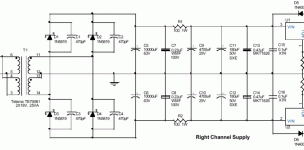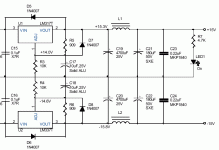I'm about to begin my new Classe Preamp Clone and I want your comments on my Power Supply. This is what can probably be called an overkill supply, but I got most of the parts in stock. Let me know want you think and how can I improve it further.
I will post two parts of the gif picture (before and after the regulator). The complete pdf file will also be posted.
Thanks in advance...
I will post two parts of the gif picture (before and after the regulator). The complete pdf file will also be posted.
Thanks in advance...
Attachments
No, it is not an overkill at all. PS transformer rating is way too low to qualify as an overkill. Caps following the regulators are really excessive. 317/337 provide some kind of minimal acceptable sound quality in general, but it really matters what exactly are they going to power in this case (sorry, unfamiliar with Classe circuits). There are many fast opamp- pass transistor based circuits on this forum, which will beat a 317 unconcious. There are also interesting shunt regulators. If you do some search you'll find a wealth of regulator info here. Just curious: why a Classe clone?
cheers
peter
cheers
peter
It simply seems overkill from the amount of parts used, when comparing for instance to a simple supply used in Pass preamps: http://www.passlabs.com/pdf/aleph/apserv17.pdf
Getting really good regulation doesn't necessarily have to produce good sound. Some people already commented that a simple pass trsnsistor provides for very good sonics.
I would imagine that the best ways to figure out the merits of a supply is to built few of them and check with a circuit how it sounds. Then you can add additional stages of filtering and bypassing.
Getting really good regulation doesn't necessarily have to produce good sound. Some people already commented that a simple pass trsnsistor provides for very good sonics.
I would imagine that the best ways to figure out the merits of a supply is to built few of them and check with a circuit how it sounds. Then you can add additional stages of filtering and bypassing.
Getting really good regulation doesn't necessarily have to produce good sound
Very possibly. But a set of 317/337, although ubiquitous in commercial amps sound positively 'grey' and dynamically challenged.
I am not familar with the Classe preamp as well. I assume that it draws minimual current just like an ordinary preamp (see 100ma?).
a few observations:
1) the R1/R2 (100ohm each) seem to be awefully big. With good ripple rejection of the 317/337 regulators, you probably don't need them.
2) if I have to, I would put big caps after the LM, not before.
3) I think overall the circuitry is complicated (too complicated?).
a few observations:
1) the R1/R2 (100ohm each) seem to be awefully big. With good ripple rejection of the 317/337 regulators, you probably don't need them.
2) if I have to, I would put big caps after the LM, not before.
3) I think overall the circuitry is complicated (too complicated?).
2) if I have to, I would put big caps after the LM, not before.
And why exactly? Even the datasheet doesn't endorse that.
analog_sa said:
And why exactly? Even the datasheet doesn't endorse that.
did the datasheet recommend BG caps, gold-plated RCA, aluminum pads, or heatsinks dipped in dielectric oil?
Seriously, my thinking or guessing is that a regulated PS will have high transiant internal resistance (it cannot output a lot of current for a very brief period of time). Having a large "resevoir" after the regulator will help cure that.
Well, normally, preamps don't require sudden current draws. But the caps are often useful for noise reasons.
Hi,
Exactly.
And for most of their life the regulators won't have to regulate either.
It's wrong to look at this as a regulated supply, it is not.
The entire topology is exactly what I used in the PSU of one of my preamps, the juices come straight from the caps and the regs can be viewed as trickle chargers providing good isolation from the mains by the same token.
You'll often see tube amp tricks implemented in Classe designs.
At least I often spot them...
Cheers,😉
But the caps are often useful for noise reasons.
Exactly.
And for most of their life the regulators won't have to regulate either.
It's wrong to look at this as a regulated supply, it is not.
The entire topology is exactly what I used in the PSU of one of my preamps, the juices come straight from the caps and the regs can be viewed as trickle chargers providing good isolation from the mains by the same token.
You'll often see tube amp tricks implemented in Classe designs.
At least I often spot them...
Cheers,😉
Mad_K said:
both designs are foundamentally flawed as it has more capacitance after the regulators, something even the datasheet does not endorese.
🙂
I don't know how much current a pre-amp draws (less than 100ma I guess?) but it cannot be too much. In that case, wouldn't it just be easier and cleaner to use unregulated one going through an R/C low-pass filter (with big caps)?
millwood: As a practical matter, for class A preamps, a simple RC will work just fine. It's not as cool as active regulation, though. I look at it much the same way that Frank does.
millwood said:
both designs are foundamentally flawed as it has more capacitance after the regulators, something even the datasheet does not endorese.
🙂
which datasheet?
Hi,
The LM317T.
Not that it matters in this context, it doesn't.
Cheers,😉
which datasheet?
The LM317T.
Not that it matters in this context, it doesn't.
Cheers,😉
fdegrove said:Hi,
The LM317T.
Not that it matters in this context, it doesn't.
Cheers,😉
Where are the LM317's in the TNT-designs😕
Hi,
Haven't looked.
I was reffering to the Classe PSU...
Sorry if I confused you,😉
Where are the LM317's in the TNT-designs
Haven't looked.
I was reffering to the Classe PSU...
Sorry if I confused you,😉
- Status
- Not open for further replies.
- Home
- Amplifiers
- Solid State
- Good supply for preamp, Comments?



